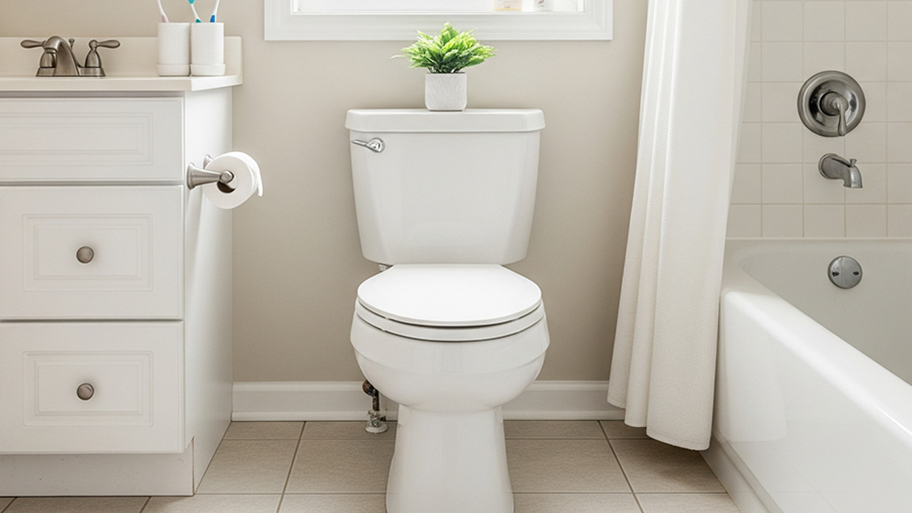
A burst pipe is a homeowner’s worst nightmare—but you can get ahead of the potential expense. This guide will help you budget for burst pipe repair costs.
On windy days, the water in your toilet bowl drops due to decreased pressure within the plumbing system


Have you ever noticed that on a windy day, your toilet water seems lower than usual? This is actually a common occurrence and, luckily, is not usually a cause for concern. This phenomenon is related to the air pressure within the toilet system. You can understand it better thanks to a scientific principle on fluid dynamics called Bernoulli’s principle.
Yes, this equation that focuses on fluid dynamics can also apply to the fluctuation of toilet water levels. The principle states that when there is an increase in fluids, there is a simultaneous decrease in pressure.
In the case of your toilet water levels, when pressure shifts within the pipe system, the water in the toilet bowl is consequently affected. With a decrease in pressure within the pipes, there is a suction effect. The toilet water is pulled to this area of low pressure, and as a result, water levels drop.
You can further understand this phenomenon by considering how the vent stack contributes to the toilet system. To troubleshoot this issue, you can try adjusting the water level in the toilet bowl.

Most households feature plumbing systems that include a vent stack. Within the plumbing system, the vent stack serves to transport sewage gases outside and prevent their odors from coming inside. In addition, it allows for air to flow through the pipes, which results in the wastewater draining effectively.
The vent stack extends from the downward-leading drainage pipe and up through the roof—as a result, the open air directly on top of the stack can affect the air pressure in the toilet.
When the water level in your toilet drops, the vent stack is likely the culprit. The outside air flows directly on top of the highest opening of the vent stack, so when there is a storm (or powerful winds), the winds can blow through this opening, lowering the air pressure in the drainage pipe.
Without strong winds, the air pressure within the vent pipe is lower, causing an increase in air pressure in the toilet. The air pressure increases throughout the toilet plumbing, resulting in higher water levels in the toilet bowl. Basically, when the wind fluctuates, the water levels in the toilet bowl tend to respond accordingly.
When debris builds up within the vent stack, the negative pressure within the plumbing system leads to slow drainage and loud, gurgling noises in your toilet. If the problem goes unfixed, you risk having issues such as a clogged drain or sewer smells.
To avoid this problem, you can install a screen or filter over the top of the vent stack.
Note: Sewer odors can pose health risks, so it’s important to call a plumber near you if this issue persists.
During stormy weather, ice and snow can cause a clogged vent stack. You can fix this by installing a pipe insulation system around the vent stack.
Another issue that could be contributing to lowered water levels in the toilet bowl is the pipe placement—the pipe leads wastewater away from the toilet. It should be pitched away from the toilet. If it’s pitched toward the toilet, this may affect the water level.
Additionally, if there is any obstruction to the pipe (a crack or opening), the water level could change since water is leaking. If you notice water leaking anywhere around the toilet, you should call a local plumber immediately. While you can implement temporary fixes for pipe leaks, it’s important to repair the pipes quickly, as leaks can cause structural damage and even pose health risks.
The wax ring is between the toilet and closet flange on the floor—the flange secures the toilet to the floor and connects to the drainpipe. If you notice water splashing on the floor or foul odors coming from the bathroom, the wax ring could be working ineffectively. The wax seal should last your toilet’s life, so if you observe these odors after a windy day, call a plumber to diagnose the issue.
From average costs to expert advice, get all the answers you need to get your job done.

A burst pipe is a homeowner’s worst nightmare—but you can get ahead of the potential expense. This guide will help you budget for burst pipe repair costs.

Worried about water leaking around your toilet? You may have a faulty toilet flange. Learn more about the cost to replace a toilet flange in our guide.

This guide to toilet installation cost covers what you can expect to pay when adding a new toilet to an existing or new bathroom.

Your shower pan is an unsung hero that can prevent leaks and flooding in your bathroom. Learn how to spot a leaking shower pan and ways to fix it.

Most toilets use a 3-inch drainpipe, but certain toilets may deviate from the norm. This guide will help you understand toilet drainpipe sizes to avoid clogs.

Linear shower drains offer several stylistic options for your bathroom, but they can come at a cost. Keep reading to learn about linear shower drain pros and cons.